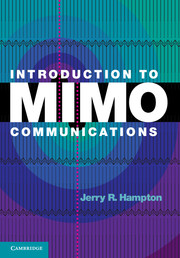Book contents
- Frontmatter
- Contents
- Preface
- 1 Overview of MIMO communications
- 2 The MIMO capacity formula
- 3 Applications of the MIMO capacity formula
- 4 RF propagation
- 5 MIMO channel models
- 6 Alamouti coding
- 7 Space-time coding
- 8 Spatial multiplexing
- 9 Broadband MIMO
- 10 Channel estimation
- 11 Practical MIMO examples
- Appendices
- References
- Index
1 - Overview of MIMO communications
Published online by Cambridge University Press: 05 December 2013
- Frontmatter
- Contents
- Preface
- 1 Overview of MIMO communications
- 2 The MIMO capacity formula
- 3 Applications of the MIMO capacity formula
- 4 RF propagation
- 5 MIMO channel models
- 6 Alamouti coding
- 7 Space-time coding
- 8 Spatial multiplexing
- 9 Broadband MIMO
- 10 Channel estimation
- 11 Practical MIMO examples
- Appendices
- References
- Index
Summary
This chapter lays the foundations for the remainder of the book by presenting an overview of MIMO communications. Fundamental concepts and key terminology are introduced, and a summary of important matrix properties is provided, which will be referred to throughout the book. Some experimental results showing the benefits of MIMO are also presented.
What is MIMO?
Multiple Input Multiple Output communications, abbreviated MIMO,and normally pronounced like “My-Moe,” refers to a collection of signal processing techniques that have been developed to enhance the performance of wireless communication systems using multiple antennas at the transmitter, receiver, or both. MIMO techniques improve communications performance by either combating or exploiting multipath scattering in the communications channel between a transmitter and receiver. MIMO techniques in the first category combat multipath by creating what is called spatial diversity, and those techniques that exploit multipath do so by performing spatial multiplexing. These two concepts are introduced in this chapter, and we will have much more to say about them throughout the remainder of the book. The subject of MIMO communications is the study of spatial diversity and spatial multiplexing techniques.
Figures 1.1 and 1.2 show block diagrams of generic MIMO communication systems. As indicated, the characteristics of the system depend on whether the focus of the MIMO processing is on creating spatial diversity, which improves reliability by combating fading, or if the purpose is to maximize throughput by performing spatial multiplexing.
- Type
- Chapter
- Information
- Introduction to MIMO Communications , pp. 1 - 27Publisher: Cambridge University PressPrint publication year: 2013



